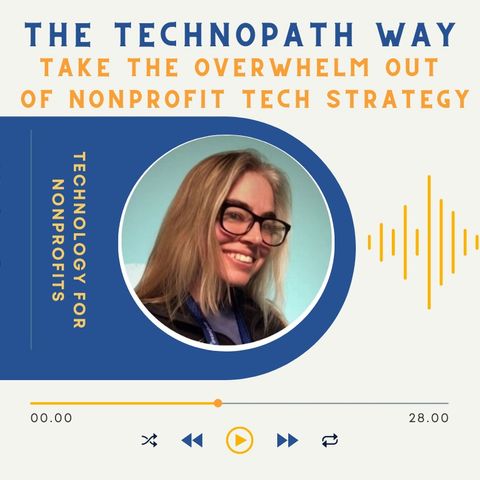Avoid Being Oversold on Technology

Download and listen anywhere
Download your favorite episodes and enjoy them, wherever you are! Sign up or log in now to access offline listening.
Description
Never miss an episode or recap again! Sign up for our weekly newsletter, The Technopath Way Tips, here: https://www.http://technopath.ac-page.com/the-technopath-way-sign-up Overselling: What is it? How do we avoid it? What do...
show moreOverselling: What is it? How do we avoid it? What do we do if it happens to us?
Nonprofits are often approached by software salespeople promising to revolutionize their work and streamline their operations. However, it's not uncommon for these salespeople to oversell what their software can do. They may make claims that aren't accurate or that the software can't deliver. This can be especially dangerous for nonprofits who often have limited resources and can't afford to invest in software that doesn't meet their needs.
By taking these steps, nonprofit organizations can make informed decisions about software purchases and avoid overselling. It's important to take the time to evaluate software products carefully to ensure that they meet the organization's needs and expectations. If you are a consultant, be sure to heed these warnings.
There are several warning signs that a salesperson may be overselling a software product to a nonprofit organization, including:
- Promising too much: If the salesperson is making unrealistic claims about the capabilities or benefits of the software, this may be a red flag that they are overselling.
- SHOW DON’T TELL! If they say it can do it, say let me see it before I sign the contract.
- Focusing on the sale, not the needs of the nonprofit: If the salesperson seems more interested in closing the deal than in understanding the nonprofit's unique needs and goals, this may be a sign that they are overselling.
- Not providing detailed information: If the salesperson is unwilling or unable to provide detailed information about the software's features, functions, and limitations, this may be a sign that they are overselling.
- Pressuring for a quick decision: If the salesperson is pushing for a quick decision or trying to rush the nonprofit into signing a contract, this may be a sign that they are overselling.
- Making promises that can't be backed up: If the salesperson is making promises that seem too good to be true or that they can't back up with evidence or references, this may be a sign that they are overselling.
- Ignoring the nonprofit's questions or concerns: If the salesperson is not listening to the nonprofit's questions or concerns, or is dismissive of their feedback, this may be a sign that they are overselling.
- Pushing add-ons or upgrades: If the salesperson is recommending expensive add-ons or upgrades that are not necessary for the nonprofit's needs, this may be a sign that they are overselling.
Tips to Avoid Being Oversold:
- Clearly define your needs and requirements before engaging with software salespeople. This will help you identify the features and functionality that are essential to your organization.
- Ask for demos and trials before committing to anything. This will allow you to see the software in action and get a better sense of its capabilities.
- Check references and read reviews from other nonprofits who have used the software. This can give you a better idea of whether the software meets the needs of organizations like yours.
- Don't be afraid to negotiate. Software salespeople may be willing to work with you on pricing or feature sets if you ask.
What to Do If It Happens to You
Even with the best research and due diligence, it's still possible to be oversold by a software salesperson. We’ve seen this happen before at smaller nonprofits where an executive or even volunteer purchases a product quickly to meet an urgent need. If you find yourself in that situation, here are a few steps you can take:
- First, be honest with the salesperson about your concerns. Explain the specific features or functionality that you were promised but that the software doesn't deliver.
- Ask if there are workarounds or alternative solutions that can be used to address your needs. Solution architechts are creative people. That’s why they built the app in the first place! They could get the clearance to design something for you that would benefit many nonprofits.
- If the salesperson is unable or unwilling to address your concerns, escalate the issue to a manager or supervisor. They may have more authority to offer a solution or disappointingly refund.
Links Mentioned during the episode:
Episode 210 - How to Choose a Database for Your Nonprofit:
https://www.spreaker.com/user/15193886/pros-and-cons-of-salesforce-for-nonprofi
Article by Paul Ginsberg and Eli Kaufman evaluating CRMs:
https://www.linkedin.com/pulse/nonprofits-when-salesforce-great-choice-paul-ginsberg/?trackingId=pPt8H7tlRd6fM4Da4Lr9Og%3D%3D
Digital Wireframing Resources:
LucidChart - https://www.lucidchart.com/pages/
elements.cloud
Find a webinar Sarah hosted with Matt Henry showing how to use elements.cloud to outline an actual nonprofit’s needs in our community Lunch and Learn recordings: npsp.academy.mn.co
Information
| Author | Sarah Epting |
| Organization | Sarah Epting |
| Website | - |
| Tags |
Copyright 2024 - Spreaker Inc. an iHeartMedia Company

Comments